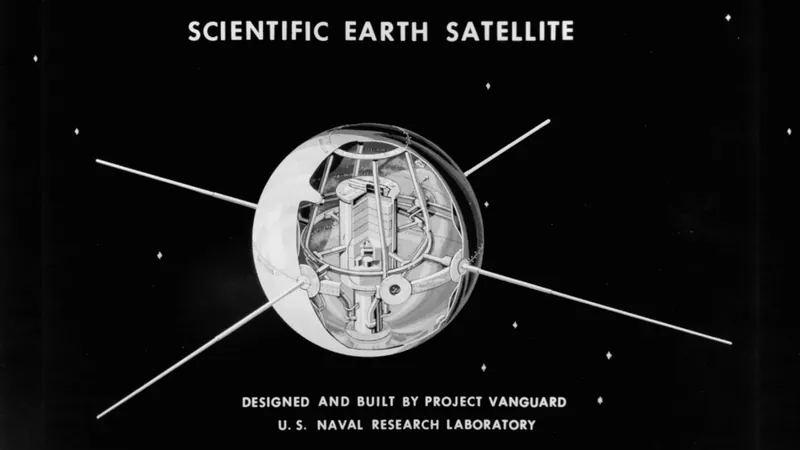
After 67 Years in Orbit, Scientists Eye the Retrieval of Vanguard 1, Earth's Oldest Satellite!
2025-04-04
Author: Ling
Introduction
In a remarkable journey through space that began during the height of the Cold War space race, Vanguard 1 stands as a testament to human ingenuity. Launched on March 17, 1958, it is the second satellite sent into orbit by the United States, following the infamous failure of the Vanguard program that initially left the country red-faced. This tiny, 1.46-kilogram aluminum sphere, equipped with solar panels, was the first satellite to harness solar energy – a groundbreaking accomplishment at the time.
Vanguard 1's Journey
While its compatriot, Explorer 1, succumbed to the atmosphere in 1970, Vanguard 1 continues to thrive in an elliptical orbit around Earth, approximately 410 miles (660 kilometers) at its lowest point (perigee) and as high as 2,375 miles (3,822 kilometers) at its peak (apogee). Thanks to meticulous tracking efforts, scientists know exactly where Vanguard 1 is located, despite it no longer transmitting signals since 1964.
Proposed Retrieval Plans
Recently, a diverse team of engineers, historians, and researchers proposed ambitious plans to retrieve this historical artifact back to Earth. Their goal? To conduct a close examination of Vanguard 1 and learn more about the satellite's state and the aging process in space. While this notion is not officially endorsed by the organizations they represent, it highlights an increasing interest in archiving and understanding space heritage.
Scientific Community Opinions
According to Matt Bille, an aerospace research analyst, the concept of salvaging Vanguard 1 is generating buzz in the scientific community. "While we've certainly talked about this before, this particular proposition deserves serious consideration," he explained. The team elaborates that a successful mission could offer insights into the satellite’s solar cells, batteries, and the impacts of micrometeorite strikes over nearly seven decades in space.
Challenges in Retrieval
However, retrieving a satellite that has been orbiting for so long poses significant challenges. Vanguard 1's small size and delicate materials require careful handling, and the endeavor would need the collaboration of a well-coordinated mission team equipped with advanced technology. Ideas for the retrieval suggest lowering the satellite into a more accessible orbit or even transporting it to the International Space Station (ISS) for eventual return to Earth.
Potential Funding and Significance
Entrepreneurs like Jared Isaacman and Jeff Bezos, known for their ventures in space tourism and recovery projects, could potentially fund this remarkable mission. Their deep pockets and passion for space exploration may provide the necessary impetus to retrieve Vanguard 1, not just for scientific research but as a piece of living history, potentially destined for display in the Smithsonian National Air and Space Museum.
Broader Implications
Bill Raynor from the Naval Research Laboratory expressed the broader significance of bringing Vanguard 1 back, noting, "Such a retrieval would provide invaluable data about the long-term exposure of materials in space environments, offering scientists and engineers a unique opportunity to study the evolution of technologies in orbit."
Conclusion
The allure of exploring Vanguard 1 is not only about its rich historical significance but also about paving the way for the future. As efforts to deepen our understanding of space gather momentum, the prospect of reclaiming our very first satellites—and learning from their experiences—represents a thrilling next step in humanity's ongoing quest to explore the cosmos. The challenge is formidable, but the rewards could be extraordinary! Will we see Vanguard 1 brought back home? Only time will tell!




 Brasil (PT)
Brasil (PT)
 Canada (EN)
Canada (EN)
 Chile (ES)
Chile (ES)
 Česko (CS)
Česko (CS)
 대한민국 (KO)
대한민국 (KO)
 España (ES)
España (ES)
 France (FR)
France (FR)
 Hong Kong (EN)
Hong Kong (EN)
 Italia (IT)
Italia (IT)
 日本 (JA)
日本 (JA)
 Magyarország (HU)
Magyarország (HU)
 Norge (NO)
Norge (NO)
 Polska (PL)
Polska (PL)
 Schweiz (DE)
Schweiz (DE)
 Singapore (EN)
Singapore (EN)
 Sverige (SV)
Sverige (SV)
 Suomi (FI)
Suomi (FI)
 Türkiye (TR)
Türkiye (TR)
 الإمارات العربية المتحدة (AR)
الإمارات العربية المتحدة (AR)